Ultimate Guide to Skill Inventory Tools 2025
Explore how skill inventory tools are revolutionizing career navigation in 2025, helping professionals align their skills with job market demands.
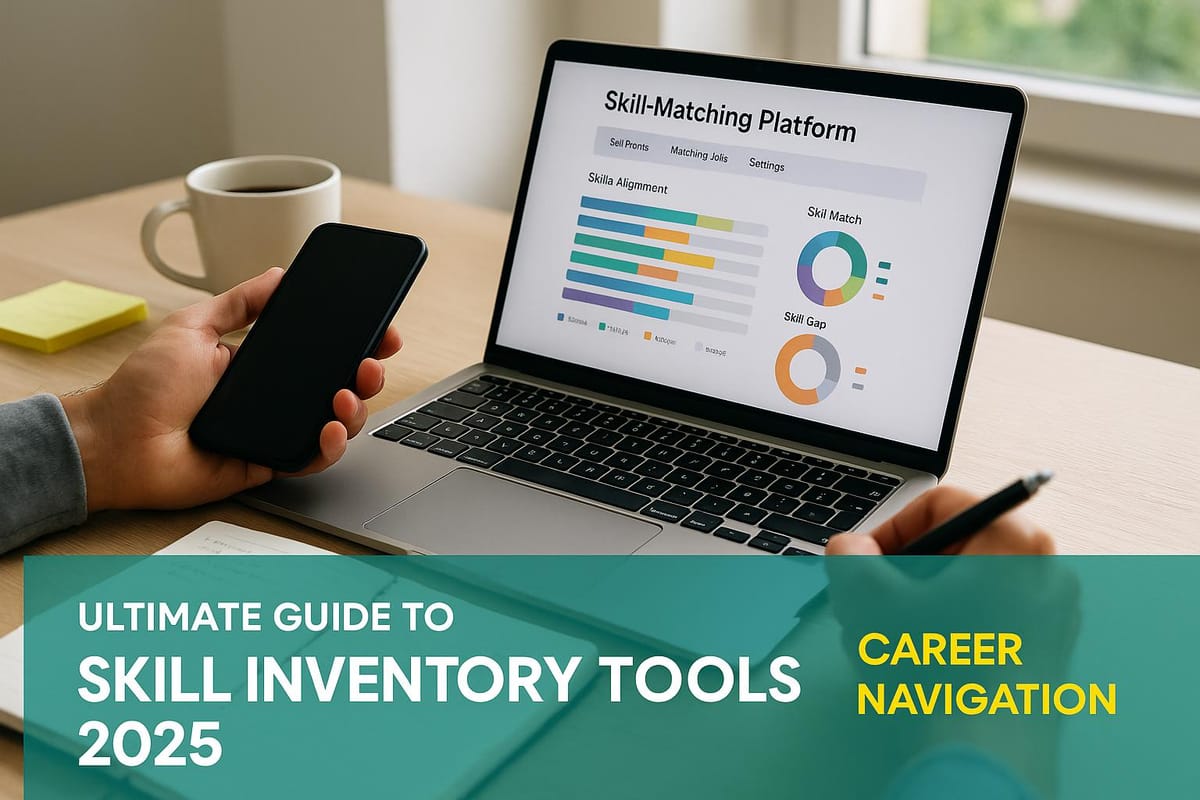
Skill inventory tools are reshaping how professionals navigate the job market in 2025. These tools go beyond traditional resumes by analyzing your skills, aligning them with career goals, and highlighting transferable abilities. With AI and automation transforming industries, staying competitive means understanding which skills are in demand and how to present them effectively.
Key takeaways:
- What they do: Catalog and analyze your skills, provide career insights, and help tailor job applications.
- Why they matter: They address challenges like automation-driven job shifts and "experience gaps" by identifying transferable skills.
- Features to look for: AI-powered assessments, ATS integration, and user-friendly interfaces.
- Top tools: Platforms like iMocha, TalentGuard, and Skills Base cater to different needs, from students to mid-career professionals.
For those navigating work transitions or planning long-term growth, skill inventory tools are becoming essential. They not only help you track your skills but also align them with market demands, giving you a clearer path to success.
Skills Management Software | Build Your Skills Based Organization
Key Features to Look for in Skill Inventory Tools
Skill inventory tools come in all shapes and sizes, but the right features can turn a simple tracker into a powerful career tool. Here's what makes some tools stand out from the rest.
AI-Powered Skill Assessments
AI-powered skill assessments bring precision to the table, using natural language processing and machine learning to analyze your abilities. These tools often uncover strengths you might not even realize you possess.
For instance, if you describe "leading a cross-functional team through a challenging product launch", advanced AI can pick up on skills like leadership, project management, communication, and problem-solving - even if you never explicitly listed them. This kind of analysis doesn’t just stop at identifying your current skills; it can also predict future needs, improving accuracy by up to 25%.
Another major advantage is how these tools help reduce bias. Unlike human evaluators who might unconsciously favor certain backgrounds or experiences, AI relies on data-driven analysis. This levels the playing field for groups like immigrants, career changers, or recent grads who might otherwise face hidden biases.
Some tools even include real-time scenario simulations to evaluate abilities like problem-solving, communication, and emotional intelligence. These simulations act like ongoing practice interviews, constantly sharpening your understanding of your strengths. Plus, they often integrate with job search platforms, ensuring your precise skill profile reaches the right recruiters.
Integration with Job Search Platforms
With 98.4% of Fortune 500 companies using Applicant Tracking Systems (ATS), your skill inventory tool needs to sync seamlessly with these platforms. The best tools ensure your skills are presented in a way that ATS platforms can understand, giving you a better shot at standing out.
"Many employers use applicant tracking systems to accept job applications. The closer a match you are to the requirements, the better your chances of getting selected." - Alison Doyle, Career Expert
Advanced tools can even compare job postings with your skill inventory in real time, tailoring applications automatically and increasing response rates. When you consider that the average job posting gets hundreds of applications, this kind of dynamic matching can make a big difference.
Integration with platforms like LinkedIn, Indeed, and ZipRecruiter also simplifies the job search process. For example, jobs using Indeed Apply are clicked on 20% more often than others, and simplified application processes can lead to up to 5X more completed applications. When your tool can auto-fill applications with relevant, tailored information, you’re saving time and boosting your chances.
Networking is another critical piece. With up to 70% of job opportunities never publicly posted and networking accounting for up to 80% of job placements, tools that connect with networking platforms can help you identify valuable contacts at companies where your skills are in demand.
By using API integrations and pre-built connections with major job platforms, these tools ensure that updates to your skill profile - like a new certification or experience - are instantly reflected across all your job search channels.
User-Friendly Interfaces and Accessibility
While powerful features like analytics and ATS integration are essential, they’re only useful if the platform is easy to navigate. A user-friendly interface ensures that everyone, from recent grads to seasoned professionals, can make the most of these tools.
The best platforms use progressive disclosure, introducing basic features first and revealing more advanced options as users grow comfortable. This approach helps reduce the overwhelm that can come with too many choices upfront.
Accessibility is another key factor. Platforms should be mobile-responsive, support multiple languages, and include features like screen reader compatibility, keyboard navigation, and adjustable text sizes. These are especially important for immigrants adapting to new job markets or users with specific accessibility needs.
A smooth onboarding process is also crucial. When platforms guide users through key features step-by-step, they’re more likely to stick with the tool and use it effectively. Contextual help and tooltips that appear exactly when needed can make the learning curve almost nonexistent.
Data visualization is another standout feature. Tools that use charts, graphs, and skill maps make it easier to spot gaps and track progress over time. For visual learners, these graphics can be far more effective than text-heavy reports, offering a clear snapshot of where they stand and where they’re headed.
Top Skill Inventory Tools for 2025
The landscape of skill inventory tools has shifted dramatically, now offering AI-powered assessments and comprehensive workforce planning features. Whether you're just starting your career or making a transition, the right tool can redefine how you present your professional skills. This guide explores some of the top tools available and compares their features to help you find the perfect match for your needs.
Overview of Leading Tools
iMocha is a standout platform for data-driven skill management. Rated 4.4/5 on G2 from 267 reviews, it boasts a vast library of over 2,500 technical and non-technical skills. Its AI-powered skills taxonomy aligns your abilities with job requirements, making it a go-to for organizations looking for precision. The platform offers custom pricing, with free demos available for a test run.
TalentGuard excels in talent planning and internal mobility, earning a G2 rating of 4.7/5, albeit from just three reviews. It offers features like succession planning and career pathing, enabling employees to map out their growth within an organization. This tool is especially valuable for companies focused on retaining and developing their workforce.
Skills Base caters to small businesses with its simple, flexible pricing model. It starts with a free plan for up to 25 users, and paid plans begin at just $2 per user per month. With a G2 rating of 4.6/5 from 18 reviews, Skills Base offers customizable skill matrices suited to various industries. It's an ideal choice for startups or growing businesses that need scalable, straightforward solutions.
Virkware is designed for medium to large companies, featuring its Mobility360 tool and detailed pulse surveys. The platform provides a free plan for up to 100 users, with paid plans starting at $7 per user per month. Its two-way talent matching system connects employees with internal opportunities while helping managers identify candidates for open roles.
LiveHire focuses on talent planning and mobility, using a two-way talent matching system to connect internal talent with opportunities. This makes it a top choice for organizations prioritizing employee development and retention. LiveHire offers custom pricing and free demos for prospective users.
HRiQ targets midsize organizations with an integrated HR suite that includes skill management, performance tracking, learning and development, and workforce analytics. Starting at $8 per employee per month, it also offers a free trial. This comprehensive approach makes it a valuable option for companies seeking a unified HR solution.
SmartRecruiters is tailored for large enterprises, combining AI-powered skill matching with robust recruitment tools. Its focus on external hiring is complemented by real-time skill matching algorithms, which streamline the hiring process for high-volume recruitment. Pricing is customized for enterprise needs.
Growthspace takes a unique approach by emphasizing project-based skill development. Instead of just cataloging existing skills, it connects employees with mentors and experts for targeted learning experiences. This makes it an excellent option for fast-growing companies aiming to quickly upskill their workforce. Growthspace also offers custom pricing and free demos.
Comparison of Features and Use Cases
Here's a snapshot of these platforms' core features and their ideal applications:
| Tool | Best For | Pricing | Key Strength | User Rating |
|---|---|---|---|---|
| iMocha | Data-driven organizations | Custom pricing | AI-powered taxonomy with 2,500+ skills | 4.4/5 (267 reviews) |
| TalentGuard | Internal talent development | Custom pricing | Succession planning and career pathing | 4.7/5 (3 reviews) |
| Skills Base | Small businesses | Free (25 users), $2/user/mo | Customizable skill matrices | 4.6/5 (18 reviews) |
| Virkware | Medium-large companies | Free (100 users), $7/user/mo | Mobility360 and pulse surveys | Not available |
| LiveHire | Internal mobility focus | Custom pricing | Two-way talent matching | Not available |
| HRiQ | Midsize organizations | $8/employee/mo | Integrated HR suite | Not available |
| SmartRecruiters | Large enterprises | Custom pricing | AI-powered external hiring | Not available |
| Growthspace | Skill development | Custom pricing | Project-based learning with mentors | Not available |
These tools go beyond basic skill tracking, helping align individual capabilities with the demands of today's job market.
For students and recent graduates, Skills Base offers a user-friendly entry point with its free tier and intuitive design. Career changers and job hoppers will appreciate iMocha's extensive skills library and AI-driven taxonomy for identifying transferable skills. Immigrants navigating visa-related employment challenges may find TalentGuard's career pathing features particularly helpful in showcasing growth potential to employers. Meanwhile, laid-off professionals looking to quickly build in-demand skills often turn to Growthspace for its mentorship-driven learning approach.
When it comes to pricing, Skills Base and Virkware stand out with their generous free tiers, making them accessible to individuals and small teams. On the other hand, enterprise-focused solutions like SmartRecruiters and iMocha offer scalable, custom pricing tailored to complex organizational needs.
"Predictive Index is the best! It is so easy to use and has been essential for building our team starting with Design to figure out what kind of team we were to using it to identify who/where we needed to hire." - Megan P., The Predictive Index Review
The growing trend of AI-powered assessments is clear across these platforms. Surveys show that 80% of companies report better hiring outcomes with skills-based assessments, and 73% say these tools speed up the hiring process. This shift toward data-driven skill evaluation is reshaping how employers and job seekers navigate the competitive talent landscape.
Up next, we'll dive into how scale.jobs compares to these top tools and why its integrated services are making waves in the industry.
How to Build and Maintain Your Own Skill Inventory
Creating a skill inventory is more than just jotting down your experiences - it’s about crafting a focused plan for your career growth. Whether you’re fresh out of college, dealing with a layoff, or plotting your next big move, a well-organized skill inventory can give you an edge in today’s competitive job market. Think of it as your personal roadmap for developing and showcasing the abilities that matter most.
Steps to Create a Personal Skill Inventory
The first step in building a skill inventory is honest self-assessment. This isn’t about listing job titles or degrees; it’s about identifying the specific skills you bring to the table.
Start by conducting a skills audit. Look at your current job, past roles, and even volunteer work. Break each experience into concrete skills. For instance, instead of writing “marketing experience,” get specific: “Google Ads campaign management,” “email automation with HubSpot,” or “conversion rate optimization.” This level of detail not only highlights your expertise but also makes your inventory compatible with applicant tracking systems (ATS) and AI tools used by recruiters.
To get a clearer picture of your abilities, use online tools like PeopleSpheres for real-time skill assessments. These platforms offer quizzes tailored to job tasks, helping you uncover strengths you may not have realized you had. Tools like scale.jobs can also help translate your updated inventory into optimized job applications.
Once you’ve identified your skills, organize them in a structured format. A spreadsheet works well - create columns for skill categories, proficiency levels, years of experience, and specific examples. Include both hard skills (like “Python programming” or “financial modeling”) and soft skills (like “team leadership” or “stakeholder communication”). For each skill, document real-world examples, such as how you used self-learning to cut costs or take on new roles. These examples can make a big difference when showcasing your abilities.
Next, align your inventory with your career goals. Research job descriptions for your target roles and identify the skills that are in demand. Tools like scale.jobs’ ATS-compliant resume builder can help you pinpoint which skills are most relevant. This ensures your inventory isn’t just a record of the past but a strategic tool for the future.
Don’t rely solely on your own judgment - seek feedback. Use performance reviews, peer evaluations, and project outcomes to validate your skills. Sometimes, others see strengths you might overlook.
Best Practices for Skill Inventory Maintenance
Building your skill inventory is just the start - keeping it updated is where the real value lies. Think of it as a living document that grows with your career.
Set a schedule for regular updates. Quarterly reviews work well - mark your calendar every three months to add new skills, update proficiency levels, and remove outdated ones. This is especially important if you’re in the middle of a career transition. For instance, professionals navigating work visa challenges can use their skill inventory to highlight transferable skills and show potential employers their growth potential. Remember, what was cutting-edge two years ago might now be standard practice - your inventory should reflect what’s relevant today.
If you’ve worked across different industries, focus on connecting your skills. For example, a global manufacturer once cataloged employees’ Lean Six Sigma expertise and used that data to form teams that reduced waste by 8% in one quarter, saving $1.2 million annually. Your diverse background could lead to similar cross-industry opportunities.
Use your inventory to guide your learning. Identify gaps between your current skills and the requirements of your target roles, then create a plan to bridge those gaps. This ensures you’re building skills with purpose, not just collecting them randomly.
Integrate your inventory with job search tools to maximize its impact. Platforms like scale.jobs can help tailor your skills for specific job applications. Their AI-powered resume builder highlights relevant skills, while their cover letter generator crafts compelling stories based on your experiences.
Finally, track the results of your skill-building efforts. Take note of which skills lead to interviews, job offers, or promotions. This data helps you prioritize future learning and shows the tangible benefits of maintaining your inventory.
Your skill inventory isn’t just a list of what you can do - it’s a dynamic tool that evolves with your career. By keeping it updated, aligning it with your goals, and integrating it with job search tools, you’ll be better equipped to stand out in the job market and seize new opportunities. Whether you’re climbing the corporate ladder or exploring new industries, a well-maintained skill inventory can be your secret weapon.
scale.jobs vs. Leading Skill Inventory and Job Search Platforms
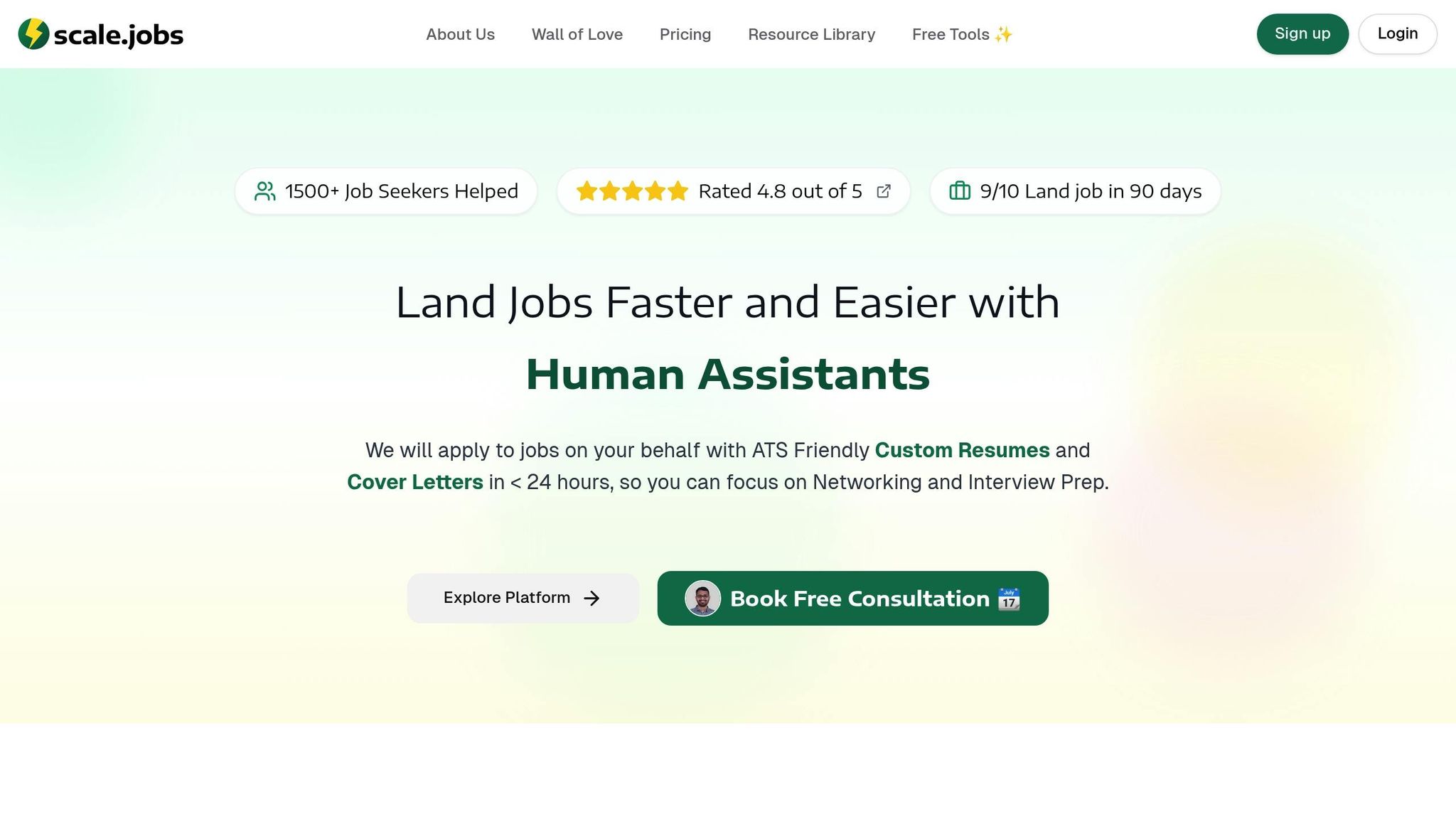
The platform you choose for your job search can significantly impact your career transition. While many job seekers gravitate toward well-known platforms like TealHQ, Jobscan, or LazyApply, these options often come with limitations that could cost you time, money, and missed opportunities. Here's a closer look at how scale.jobs measures up against these competitors - and why it might be the solution you've been waiting for.
TealHQ vs. scale.jobs: A Better Alternative
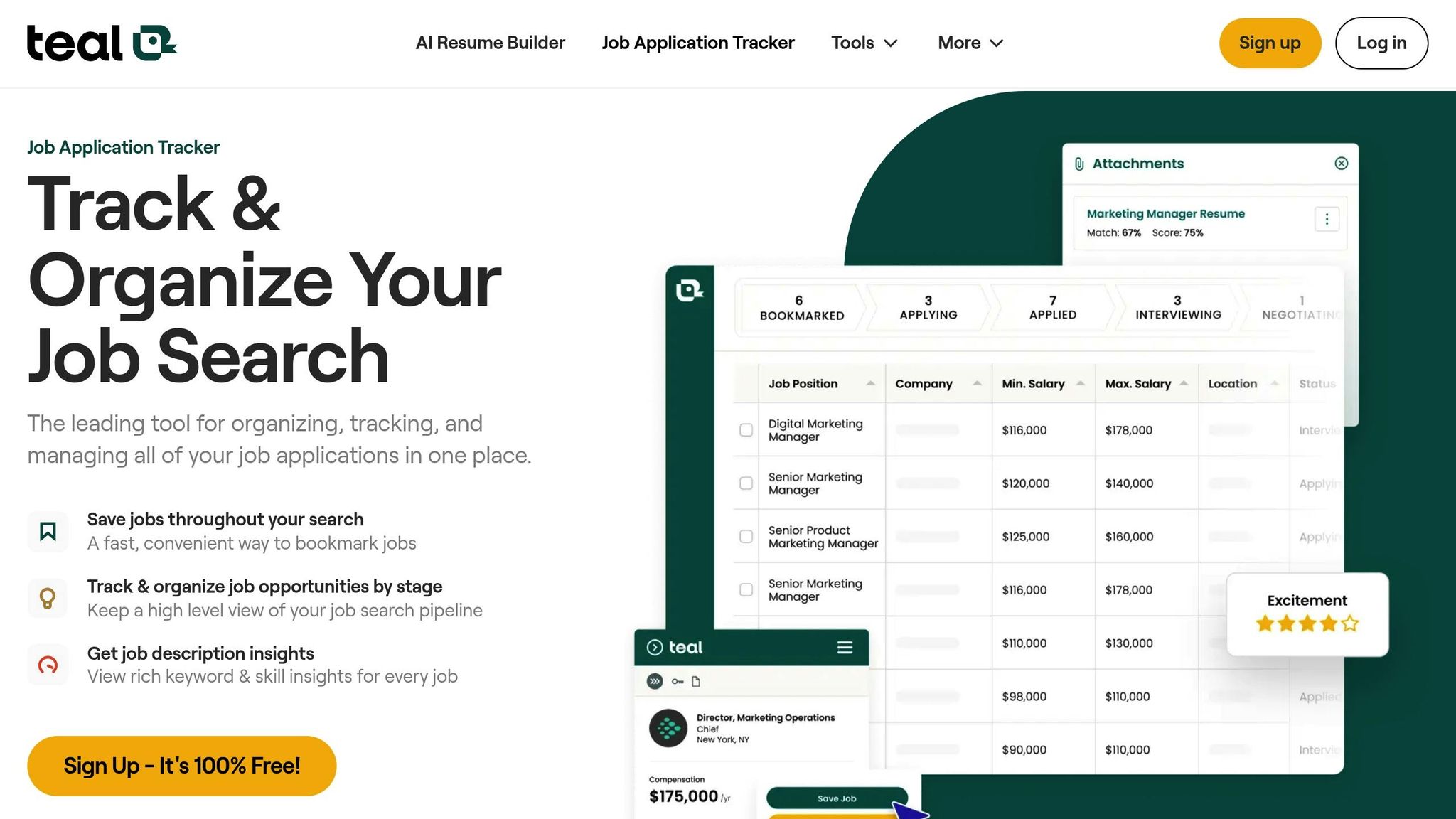
TealHQ has earned a reputation for offering tools that help with job tracking and resume optimization. However, its self-service model places the entire workload on you, from customizing applications to tracking follow-ups. For busy professionals or recent graduates juggling multiple applications, this can quickly become overwhelming.
scale.jobs takes a different approach. It offers the support of trained virtual assistants and reverse recruiters who handle the heavy lifting. They create ATS-optimized resumes, craft personalized cover letters, and submit applications on your behalf, freeing you up to focus on networking and interview prep.
The pricing structure is another area where scale.jobs stands out. TealHQ relies on monthly subscriptions that can add up over time, while scale.jobs uses a flat-fee model starting at $199 for 250 applications. Plus, with unused-credit refunds, you only pay for services you actually use - no hidden costs or ongoing commitments.
Transparency is key at scale.jobs. Through real-time WhatsApp updates and time-stamped screenshots, you get a clear view of every step in the application process. While TealHQ provides a digital dashboard to track your activity, it doesn't offer the same level of human accountability or detailed updates.
For those dealing with visa complexities or unique application requirements, scale.jobs' human touch becomes even more critical. Its assistants understand the nuances of different systems and ensure your applications are handled with care, giving you an edge in a competitive job market.
Jobscan: Good, But Not Enough
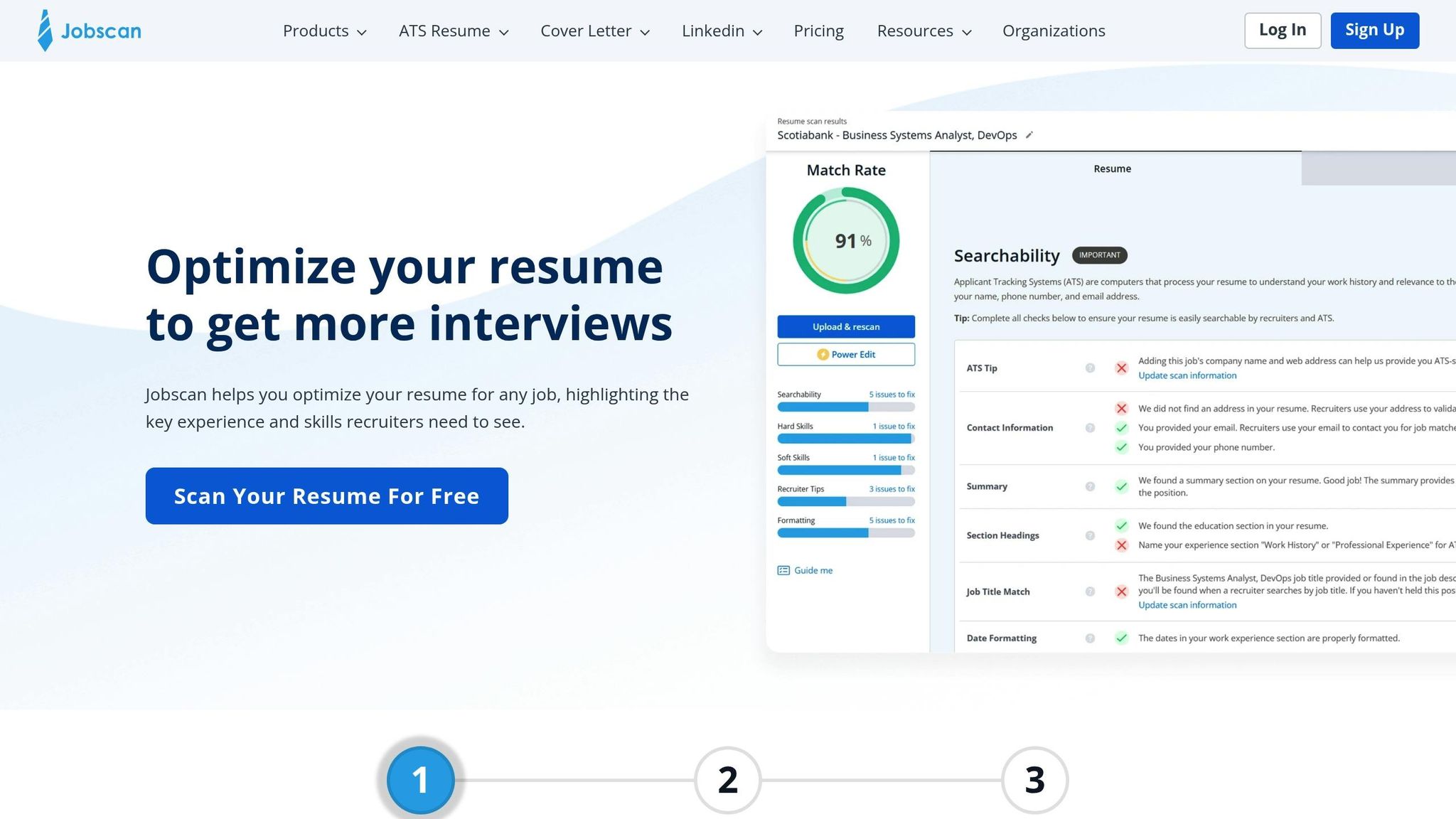
Jobscan is well-known for helping users optimize resumes for ATS systems by analyzing job descriptions and suggesting keyword improvements. While it performs this task well, its narrow focus exposes a major drawback: Jobscan stops at resume optimization.
The platform leaves you to manually customize each application, write cover letters, fill out forms, and track submissions. For job seekers applying to dozens of positions, this can feel like a second full-time job.
scale.jobs goes far beyond ATS optimization. Its AI Assistant Pro generates tailored resumes and cover letters for every application with just a click. Instead of spending hours tweaking formats and keywords, you get documents that are both ATS-friendly and appealing to recruiters.
Even the free tools on scale.jobs rival Jobscan's paid features. The resume ATS checker provides actionable insights, while tools like the salary predictor and interview question generator add extra layers of support. When you include the human assistant services, scale.jobs offers a complete solution that addresses every stage of the job search.
The platform also excels in transparency. While Jobscan offers suggestions, scale.jobs provides real-time updates and detailed tracking, so you know exactly what’s happening with your applications.
For job seekers managing high-volume applications, the time savings alone make scale.jobs a compelling choice. Instead of spending hours on application logistics, you can focus on building connections, preparing for interviews, and refining your skills.
LazyApply: Convenience at a Cost
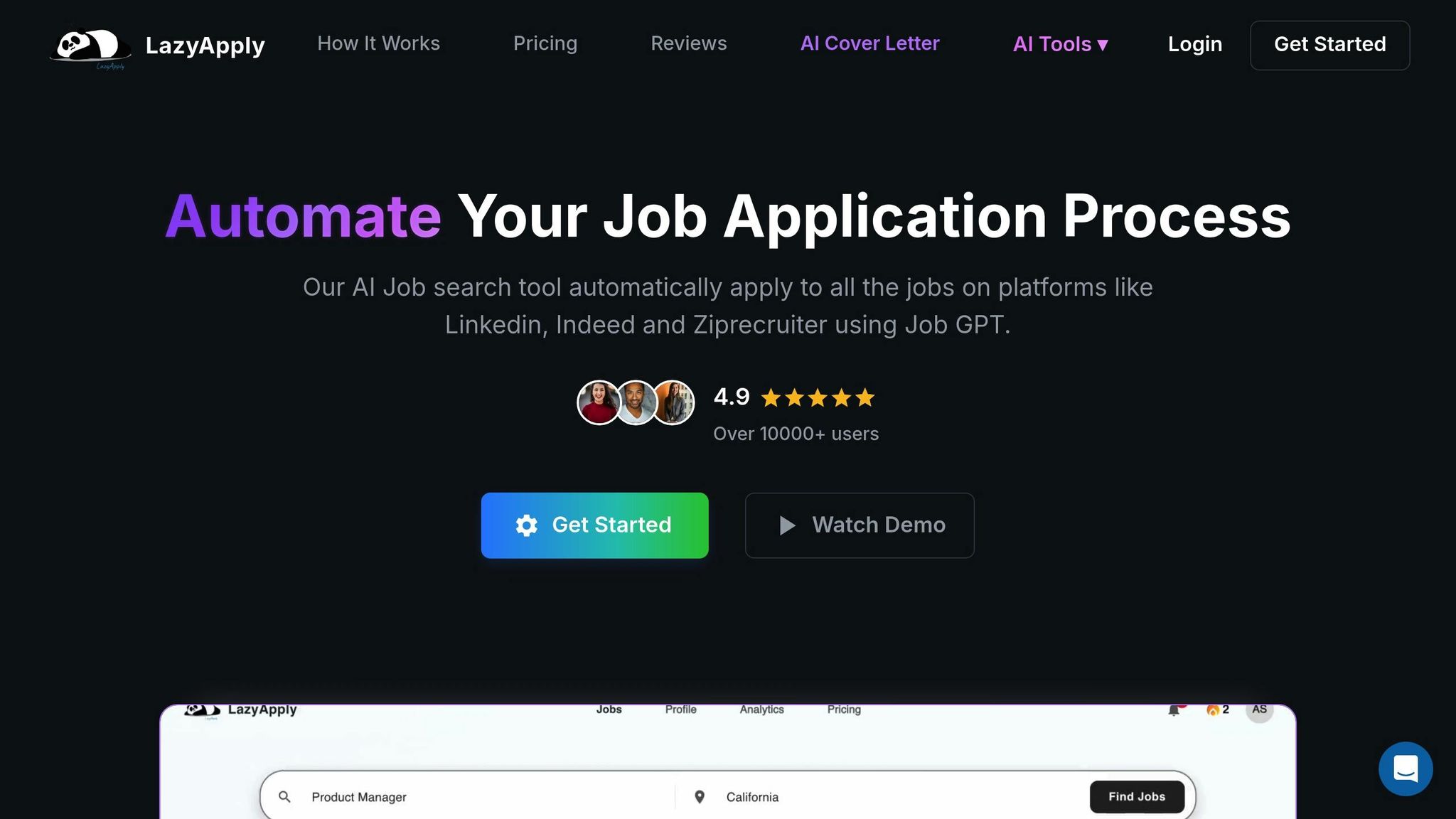
LazyApply markets itself as the ultimate time-saver, automating job applications while you sleep. However, this convenience often comes at the expense of quality. Automation without human oversight can lead to generic applications that fail to stand out.
Generic submissions hurt your chances in today’s competitive job market. LazyApply’s automation doesn’t account for the nuances of company cultures, role-specific requirements, or tailored messaging. Hiring managers can easily spot these one-size-fits-all applications, which may leave a negative impression.
scale.jobs strikes the perfect balance between automation and human intelligence. Virtual assistants handle the tedious aspects of job applications while ensuring each submission is customized and relevant. They know how to highlight your skills, adapt your experience for different industries, and address specific application fields with care.
Transparency is another area where scale.jobs outshines LazyApply. With LazyApply’s black-box system, you’re left wondering what was submitted and how your professional brand is being represented. In contrast, scale.jobs provides complete visibility into every application, ensuring your candidacy is presented in the best possible light.
The difference in quality control is striking. LazyApply might send your resume to roles where you’re not qualified or interested, while scale.jobs assistants apply thoughtful judgment, ensuring every application aligns with your goals. This targeted approach often results in better response rates and more meaningful opportunities.
For those navigating visa requirements, career changes, or niche industries, the human element becomes indispensable. scale.jobs assistants can adapt to these complexities in ways automated tools simply can’t.
At the end of the day, the choice comes down to how you want to be perceived. Do you want to be just another resume in a pile, or a carefully positioned candidate? With scale.jobs, you get the best of both worlds: the efficiency of automation paired with the precision of human insight. This combination can make all the difference in landing your next role.
Choosing the Right Skill Inventory Tool for Your Career Goals
Picking the right skill inventory tool isn’t a one-size-fits-all decision. Your career stage, industry, and unique challenges should guide your selection. For instance, recent graduates often benefit from tools that assess soft skills and potential, while seasoned professionals need platforms that showcase technical expertise and transferable abilities.
Your career stage plays a key role in determining the best tool. Students and new graduates should look for assessments that help identify strengths, interests, and values to steer their career choices. Tools like The Predictive Index are particularly helpful for understanding workplace behaviors and team dynamics, making them ideal for those just starting out. On the other hand, frequent job changers need tools that measure adaptability and learning agility, demonstrating their ability to succeed in different environments.
For individuals facing visa-related hurdles, a more tailored approach is essential. H‑1B applicants, international students on F‑1 visas, and those pursuing specialized visas like O‑1 or EB‑1A often need tools that emphasize transferable skills and cultural alignment. Generic assessments may miss these critical nuances, making it even more important to choose platforms designed to address such specific needs.
To get a well-rounded view of your skills, it’s a good idea to combine different types of assessments. Use the results as a foundation but refine them based on your values and the realities of your target job market. And don’t forget - your skill inventory isn’t static. Regular updates are crucial since the skills you listed six months ago might no longer reflect your current capabilities. Keeping it fresh helps you identify gaps and uncover new opportunities.
That said, skill inventory tools have their limits. While they provide useful insights, they don’t handle the entire job search process. This is where combining digital tools with human expertise can give you an edge. Platforms like TealHQ or Jobscan can help pinpoint your strengths, but they often leave you on your own to customize resumes, write cover letters, and track applications across numerous portals.
To address these gaps, some platforms blend digital precision with human support. scale.jobs is one example, offering a mix of advanced skill assessment tools and hands-on assistance. Its free features include an ATS Checker for actionable feedback, a Salary Predictor, and an Interview Questions Predictor - functions typically found in standalone tools. But the standout feature is its human assistant service, where trained virtual assistants turn your skill data into polished, tailored applications.
For professionals juggling a high volume of job applications, this combination can save over 20 hours per week. Instead of spending time navigating company portals or tweaking keywords for ATS systems, you can focus on networking, preparing for interviews, and building your skills - activities that directly influence your career progress.
The platform’s flat-fee model, starting at $199 for 250 applications, is also budget-friendly. Unlike subscription services that charge monthly regardless of usage, you only pay for what you need. With clear pricing and the option for unused-credit refunds, there’s no risk of unexpected costs during a job search.
Ultimately, your choice of tools should match both your immediate needs and your long-term goals. Basic assessments might suffice for exploratory searches or low-pressure situations. However, competitive markets and visa-related complexities often call for more advanced tools that combine digital efficiency with expert guidance.
FAQs
How do AI-powered skill inventory tools identify and predict the most in-demand skills?
AI-driven skill inventory tools use machine learning algorithms to sift through extensive job market data, including job postings, industry reports, and hiring patterns. By processing this information, these tools can pinpoint new and trending skills, monitor their demand across various sectors, and even forecast future needs.
For job seekers, this means staying ahead by honing in on in-demand skills and aligning their growth with what employers are looking for. These tools don’t just stop there - they also suggest useful learning resources and certifications to close skill gaps, making them a powerful ally for anyone looking to plan their career strategically.
What sets iMocha, TalentGuard, and Scale.jobs apart as skill inventory and job search tools?
iMocha and TalentGuard serve distinct purposes within the talent management space. iMocha focuses on skill assessments, excelling in areas like technical hiring, skill validation, and internal mobility. This makes it a go-to solution for evaluating employee competencies and ensuring the right skills are in place. Meanwhile, TalentGuard zeroes in on career development and succession planning, helping businesses align employee growth with their long-term objectives.
Scale.jobs, on the other hand, offers a tailored approach for active job seekers. Its tools include ATS-friendly resumes, AI-powered application responses, and human virtual assistants to handle the entire job search process. Unlike iMocha and TalentGuard, Scale.jobs is all about simplifying and personalizing the job hunt, making it an excellent choice for individuals navigating the competitive job market.
How do skill inventory tools benefit recent graduates and career changers in today's competitive job market?
Skill inventory tools are a game-changer for recent graduates and those switching careers in today’s competitive job market. They help you evaluate your current skill set, pinpoint areas that need improvement, and focus on building the expertise employers are looking for. By emphasizing transferable skills and aligning them with specific job requirements, these tools make crafting tailored resumes much easier, giving you an edge when applying for roles.
Platforms like scale.jobs take this concept further by blending advanced features with AI and human support. With tools like ATS-friendly resume creation, real-time updates, and straightforward one-time payment options, they streamline the job search process. This means you can spend less time worrying about administrative details and more time on networking and preparing for interviews.




![[UPDATED-2026] Job Search Strategies That Actually Work: Tips + Best Tools](/content/images/size/w600/2025/12/image-1764688576191.jpeg)